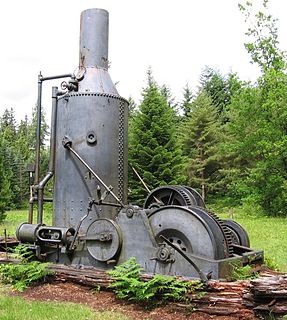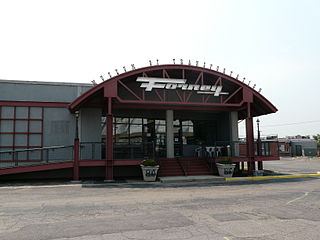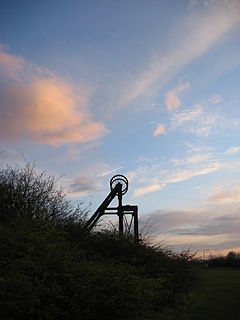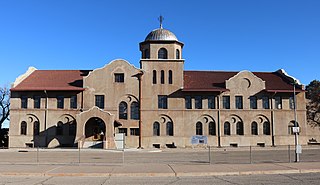
Telluride is the county seat and most populous town of San Miguel County in the southwestern portion of the U.S. state of Colorado. The town is a former silver mining camp on the San Miguel River in the western San Juan Mountains. The first gold mining claim was made in the mountains above Telluride in 1875, and early settlement of what is now Telluride followed. The town was founded in 1878 as "Columbia", but due to confusion with a California town of the same name, was renamed Telluride in 1887 for the gold telluride minerals found in other parts of Colorado. These telluride minerals were never found near Telluride, but the area's mines for some years provided zinc, lead, copper, silver, and other gold ores.

Industrial archaeology (IA) is the systematic study of material evidence associated with the industrial past. This evidence, collectively referred to as industrial heritage, includes buildings, machinery, artifacts, sites, infrastructure, documents and other items associated with the production, manufacture, extraction, transport or construction of a product or range of products. The field of industrial archaeology incorporates a range of disciplines including archaeology, architecture, construction, engineering, historic preservation, museology, technology, urban planning and other specialties, in order to piece together the history of past industrial activities. The scientific interpretation of material evidence is often necessary, as the written record of many industrial techniques is often incomplete or nonexistent. Industrial archaeology includes both the examination of standing structures and sites that must be studied by an excavation.

The Science and Industry Museum in Manchester, England, traces the development of science, technology and industry with emphasis on the city's achievements in these fields. The museum is part of the Science Museum Group, a non-departmental public body of the Department for Digital, Culture, Media and Sport, having merged with the National Science Museum in 2012.

An industrial railway is a type of railway that is not available for public transportation and is used exclusively to serve a particular industrial, logistics, or military site. In regions of the world influenced by British railway culture and management practices, they are often referred to as tramways. Industrial railways may connect the site to public freight networks through sidings, or may be isolated or located entirely within a served property.

A steam donkey or donkey engine was a steam-powered winch once widely used in logging, mining, maritime, and other industrial applications.

The California Science Center is a state agency and museum located in Exposition Park, Los Angeles, next to the Natural History Museum of Los Angeles County and the University of Southern California. Billed as the West Coast's largest hands-on science center, the California Science Center is a public-private partnership between the State of California and the California Science Center Foundation. The California Natural Resources Agency oversees the California Science Center and the California African American Museum. Founded in 1951 as the "California Museum of Science and Industry", the Museum was remodeled and renamed in 1998 as the "California Science Center". The California Science Center hosts the California State Science Fair annually.
David Plowden, is an American photographer who has made historical documentary photography of urban cities, steam trains, American farmlands, and small towns.

Otto August Kuhler was an American designer, one of the best known industrial designers of the American railroads. According to Trains magazine he streamstyled more locomotives and railroad cars than Cret, Dreyfuss and Loewy combined. His extensive concepts for the modernization of the American railroads have repercussions onto the railways worldwide until today. In addition he was a prolific artist of industrial aesthetics and of the American West in general.

The Forney Transportation Museum is a transportation museum located in Denver, Colorado.

The National Mining Hall of Fame is a museum located in Leadville, Colorado, United States, dedicated to commemorating the work of miners and people who work with natural resources. The museum also participates in efforts to inform the public about the mining industry.

Industrial heritage refers to the physical remains of the history of technology and industry, such as manufacturing and mining sites, as well as power and transportation infrastructure. Another definition expands this scope so that the term also covers places used for social activities related to industry such as housing, museums, education or religious worship, among other structures with values from a variety of fields in order to highlight the interdisciplinary character of industrial heritage. It is also argued that it includes the so-called sociofacts or aspects of social and institutional organizations, and mentifacts that constitute the attitudinal characteristics and value systems industrial heritage sites.

Prestongrange Museum is an industrial heritage museum at Prestongrange between Musselburgh and Prestonpans on the B1348 on the East Lothian coast, Scotland. Founded as the original site of the National Mining Museum, its operation reverted to East Lothian Council Museum Service in 1992.

The Minnequa Steel Works Office Building and Dispensary are historic buildings in Pueblo, Colorado. The main office building served as headquarters of Colorado Fuel and Iron Company. The medical dispensary building served as a medical clinic for treatment of minor injuries and illnesses, and in later years, as both clinic and personnel office for the Colorado Fuel and Iron Company. Opened in 1902, the six-room Spanish Mission style building contained waiting, drug, consultation, surgical and storage rooms, in addition to sleeping and office quarters for attending physicians. In 1902, as the company payroll exceeded 5,000 employees, the Dispensary handled an average of seventy-five cases daily. As employee numbers grew, medical staff also began treating families of employees. The building was used as a medical building for mill employees until the early 1990s. The Minnequa Steelworks Office Building, built in 1901, served as company headquarters until the early 1990s. Here, many office functions occurred including purchasing, finance, payroll, engineering, and other administrative functions. The building complex was listed on the National Register of Historic Places in 2002, amended to the National Level of Significance of the National Register of Historic Places in 2008, and was designated a National Historic Landmark in 2021. Owned and operated by the Steelworks Center of the West, the medical dispensary building is the home of the Steelworks Museum of Industry and Culture, which opened on January 19, 2007. The museum's exhibits include the local history of coal mining, steel production, railroads, labor, and the impact of the Colorado Fuel and Iron Company on the region. The main administration building will serve as the second phase of the Steelworks Museum of Industry and Culture in the coming years.

The Steelworks Museum is located in Pueblo, Colorado. Operated by the Steelworks Center of the West, the museum is in the historic Minnequa Steel Works Office Building and Dispensary of the Colorado Fuel and Iron Company.

The Switzerland Trail is the site of a historic 3 ft narrow gauge railroad line that was operated at different times by the Greeley, Salt Lake and Pacific Railway, the Colorado and Northwestern Railroad, and the Denver, Boulder, and Western Railroad around the turn of the 20th century in the Colorado front range mining area near Nederland, Gold Hill, and Ward. The west end of the trail is listed on the National Register of Historic Places as the "Denver, Boulder and Western Railway Historic District".

The Calumet Historic District is a National Historic Landmark District that encompasses most of the village of Calumet, Michigan. The district was designated in 1989 for the community's importance in the history of the region's copper mining industry.

A boomtown is a community that undergoes sudden and rapid population and economic growth, or that is started from scratch. The growth is normally attributed to the nearby discovery of a precious resource such as gold, silver, or oil, although the term can also be applied to communities growing very rapidly for different reasons, such as a proximity to a major metropolitan area, huge construction project, or attractive climate.

The Nottingham Industrial Museum is a volunteer-run museum situated in part of the 17th-century stables block of Wollaton Hall, located in a suburb of the city of Nottingham. The museum won the Nottinghamshire Heritage Site of the Year Award 2012, a local accolade issued by Experience Nottinghamshire. The Museum collection closed in 2009 after Nottingham City Council withdrew funding, but has since reopened at weekends and bank holidays, helped by a £91,000 government grant, and run by volunteers. The museum contains a display of local textiles machinery, transport, telecommunications, mining and engineering technology. There is a display of cycles, motorcycles, and motor cars. There are examples of significant lace-making machinery. It also houses an operational beam engine, from the Basford, Nottingham pumping station.

The National Museum of Industrial History, housed in the former facility of Bethlehem Steel in Bethlehem, Pennsylvania, is a museum affiliated with the Smithsonian Institution that seeks to preserve, educate, and display the industrial history of the nation. It holds a collection of artifacts from the textile, steel and iron, and propane gas industries. The NMIH holds a significant collection of industrial machinery on loan from the Institute's National Museum of American History. The museum also has a large collection of documents, machinery, photographs, and other archival material from Bethlehem Steel.
In the mid-19th century, Colorado Springs was a center of mining industry activity. Coal was mined in 50 mines in the area and towns, now annexed to Colorado Springs, were established to support residents of the coal mining industry.





















